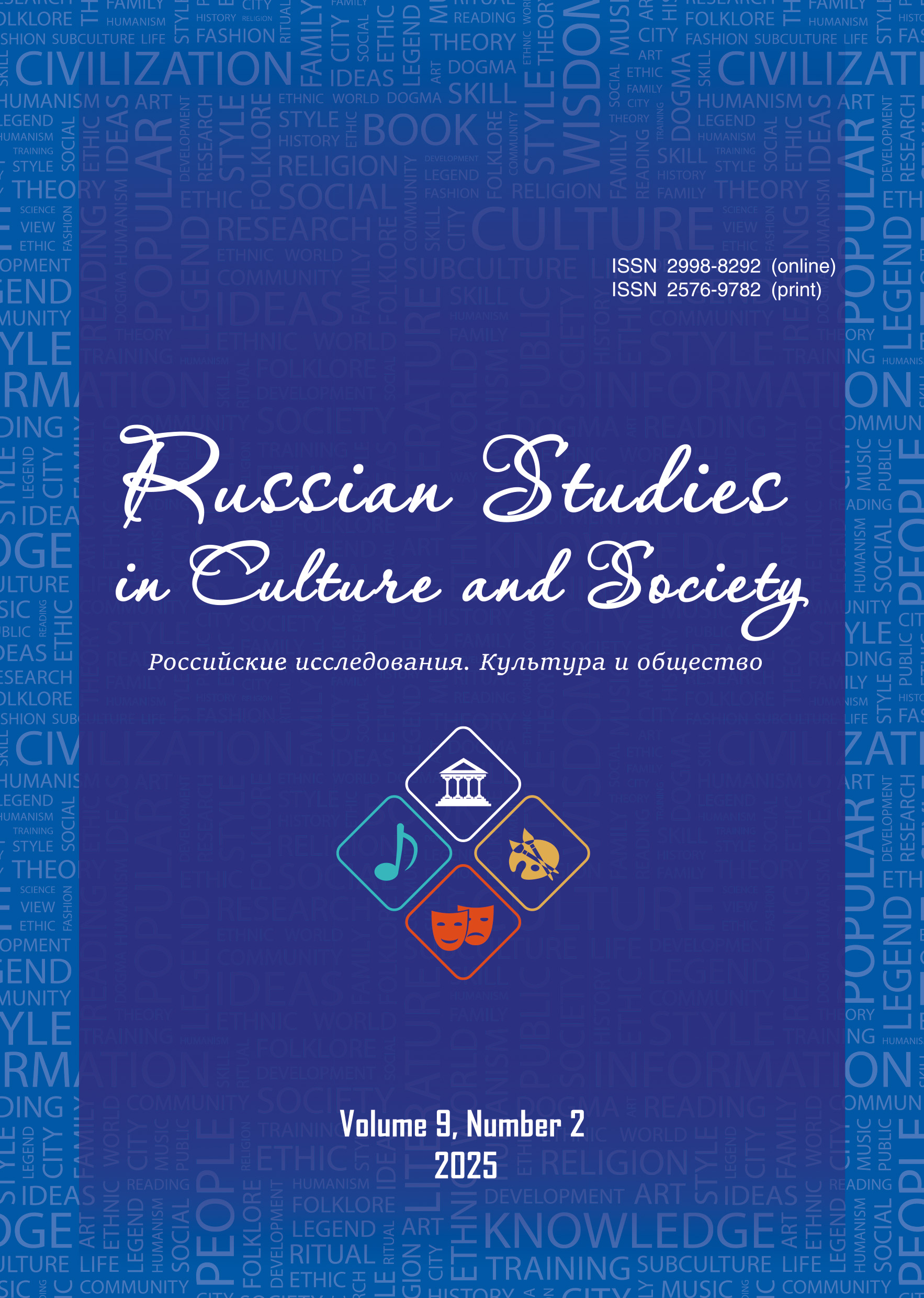A.N. Tolstoy's works of 1917-1921: The types and role of artistic conventionality
- Authors: Kiryukhina E.M.1
-
Affiliations:
- Nizhny Novgorod State Agrotechnological University n. a. L.Ya. Florentyev
- Issue: Vol 9, No 2 (2025)
- Pages: 118-139
- Section: Статьи
- Published: 30.06.2025
- URL: https://journals.rcsi.science/2576-9782/article/view/301339
- DOI: https://doi.org/10.12731/2576-9782-2025-9-2-286
- EDN: https://elibrary.ru/OMGUUZ
- ID: 301339
Cite item
Full Text
Abstract
The article examines the multi-genre works by Alexei Nikolaevich Tolstoy from 1917 to 1921 − fairy tales, short stories, novellas and plays − in which various types of artistic conventions are used. The tasks of comparing these works are subordinated to the goal of identifying the role and types of artistic convention; for this purpose, the author uses comparative, problematic, chronological, cultural-historical and biographical methods. Such structuring and comprehensive study of different types of conventionality in this historical period has not been undertaken previously and represents the scientific novelty of the article. The author highlights the conventionality in fairy tales (“Fofka”, “The Soldier and the Devil”), the types of conventionality in realistic stories and the play “Danton's Death” − psychologically motivated fantasy (visions – “In Delirium”), (dreams – “A Dream in a Thunderstorm”, “Aunt Marya Grigoryevna”, “The Tale of the Time of Troubles”, “Danton's Death”), carnival conventionality in the play “Love is a Golden Book” and the story “Count Cagliostro” and comes to the conclusion that A.N. Tolstoy's appeal to the types of artistic conventionality was a consequence of his understanding of a complex historical era and the desire to convey it in all its multidimensionality and diversity.
Keywords
About the authors
Elena M. Kiryukhina
Nizhny Novgorod State Agrotechnological University n. a. L.Ya. Florentyev
Author for correspondence.
Email: elenakiruhina@gmail.com
ORCID iD: 0000-0003-0498-6842
Doctor of Culturology, Professor
Russian Federation, 97, Gagarin Ave., Nizhny Novgorod, Russian FederationReferences
- Amfiteatrov, A. (1913). Collected Works (Vol. XVIII: The Devil in Life, Legend, and Literature of the Middle Ages). Saint Petersburg: Prosveshcheniye. Pp. 357–358.
- Baranov, V. I. (1983). Revolution and the Fate of the Artist. Moscow: Sovetskiy pisatel'. 461 p.
- Bakhtin, M. M. (1975). Questions of Literature and Aesthetics: Studies of Different Years. Moscow: Khudozhestvennaya literatura. 506 p. EDN: https://elibrary.ru/WTJALN
- Bakhtin, M. M. (1979). Problems of the Poetics of Dostoevsky. Moscow: Sovetskaya Rossiya. 318 p. EDN: VQMUYV
- Gafurova, Z. R. (2018). The Sense of the Era: A. N. Tolstoy's Play "Love is a Golden Book". New Russian Humanitarian Studies, (13), 64. EDN: https://elibrary.ru/KMCUGP
- Golubkov, S. A. (1978). The Comic in the Early Prose of A. N. Tolstoy (Abstract of PhD Dissertation in Philology). Moscow: MPKI im. N. K. Krupskoy. 24 p.
- Gornfeld, A. (1922). Review of A. Tolstoy's play "Love is a Golden Book" and the story "Nikita's Childhood". Literaturnye zapiski, (3), 17.
- Gubner, P. (1921). Is there a future for Russian literature? Vestnik literatury, (1 (25)), 3.
- Kiryukhina, E. M. (2024). The Conflict of Reality and Fantastic Fiction in Alexei Nikolaevich Tolstoy's Story "Count Cagliostro". Russian Studies in Culture and Society, 8(2), 128–144. https://doi.org/10.12731/2576-9782-2024-8-2-239 EDN: https://elibrary.ru/CGGWIZ
- Mann, Yu. V. (1978). The Poetics of Gogol. Moscow: Khudozhestvennaya literatura. 412 p. EDN: https://elibrary.ru/UENMKF
- Nikolaev, D. D. (2014). A. N. Tolstoy's play "Love is a Golden Book" and the Russian Diaspora of the 1920s. In Aleksey Tolstoy: Dialogues with Time (pp. 69–80). Moscow: IMLI RAN. EDN: https://elibrary.ru/TKZBEP
- Oklyanskiy, Yu. (1982). A Noisy Backwater (From the Lives of Two Writers). Kuibyshev: Kuybyshev Book Publishing House. 255 p.
- Petrov, Vs. (1975). The World of Art. Moscow: Izobrazitel'noe iskusstvo. 246 p.
- Polyakova, N. F. (2017). The Poetics of Fantastic Space in A. K. Tolstoy's "Upyr'" and A. N. Tolstoy's "Count Cagliostro". In Slavic World: Spiritual Traditions and Literature: Proceedings of the International Scientific Conference Dedicated to the 300th Anniversary of A. P. Sumarokov, the 200th Anniversary of A. K. Tolstoy (pp. 120–127). Tambov: Print-Service. EDN: https://elibrary.ru/VWOCOY
- Polyakova, N. F. (2016). The Real and the Fantastic in the Chronotope of A. N. Tolstoy's Story "Count Cagliostro". Yearbook of Eastern European Studies, (6), 219–231. EDN: https://elibrary.ru/ZEQMMZ
- Semibratova, I. V. (1973). Typology of Fantasy in Russian Prose of the 1930s-1940s (Abstract of PhD Dissertation in Philology). Moscow: MSU. 20 p.
- Skobelev, V. P. (1981). In Search of Harmony: The Artistic Development of A. N. Tolstoy: 1907-1922. Kuibyshev: Kuibyshev Book Publishing House. 176 p.
- Tolstaya, E. D. (2006). "Tar and Honey": Alexei Tolstoy as an Unknown Writer (1917-1923). Moscow: RGGU. 685 p.
- Tolstoy, A. N. (1922). Love is a Golden Book. Berlin: Moskva. 93 p.
- Tolstoy, A. N. (1921). Before the Paintings of Sudaykin. Zhar-ptitsa, (1), 26.
- Tolstoy, A. N. (1946-1953). Complete Collected Works in 15 Volumes. Moscow: Goslitizdat.
- Tolstoy, A. N. (1958-1961). Collected Works in 10 Volumes. Moscow: Goslitizdat.
- Tolstoy, A. N. (1923). Collected Works in 2 Volumes. Wild Years. Stories. Berlin-Pg-M.: Z. I. Grzhebin Publishing House. 271 p.
- Khaninova, R. N. (2008). Sleep-Ecphrasis and the "Living" Ecphrasis in the Prose of A. N. Tolstoy of the 1910s-1920s. Izvestiya Volgogradskogo gosudarstvennogo pedagogicheskogo universiteta. Series "Philological Sciences", (10), 150–156. EDN: https://elibrary.ru/KBXPAP
Supplementary files










